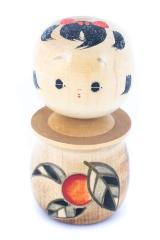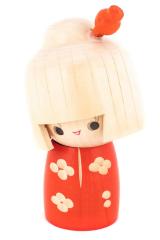Comments and Tags
Be the first to comment on this item!
Asian
Decorative Arts ➔ Kokeshi
Identifier:
2020.3.60Description:
This traditional Kijiyama kokeshi is made of a single piece of wood and has a tear-drop shaped head. The kimono displays red and green stripes as well as a maedare (apron) with red and green plum blossoms. The face has bangs and side fringe as well as a mizuhiki (red ribbon) on the head. Double eyelids that are curved on the top and straight on the bottom are also characteristic of a Kijiyama kokeshi. The Japanese characters on the back translate to "Akita Pref. Kijiyama, Ogura Kyutaro".Kokeshi are wooden dolls lacking arms or legs that were first produced in the Tohoku region of Japan. They were originally intended to be used as children's toys however they have become popular among collectors and are often used as decoration. Kokeshi can be categorized into two groups, traditional and creative. Traditional dolls are simple in design and are divided into eleven different types that coincide with the area they were created. These types have particular shapes and designs to help distinguish them. Creative kokeshi were first produced after World War II and feature unique designs, shapes, and colors that are not found in their traditional counterparts.
Date:
1950 – 1990Materials:
WoodDimensions:
6.25" h 1.5" w 1.5" dCurrent Location Status:
In StorageCollection Tier:
Tier 2Source:
Gift of Etta M. HesselinkRelated Entities:
Etta M. Hesselink (donor)Etta Hesselink and her husband John served the Reformed Church as missionaries and teachers in Japan from 1953 to 1973, and they and their five children all developed a deep appreciation for Japanese art and culture. Ogura Kyutaro (creator)
Ogura Kyutaro was a Japanese artist from the Akita prefecture known for making Kijiyama kokeshi.

